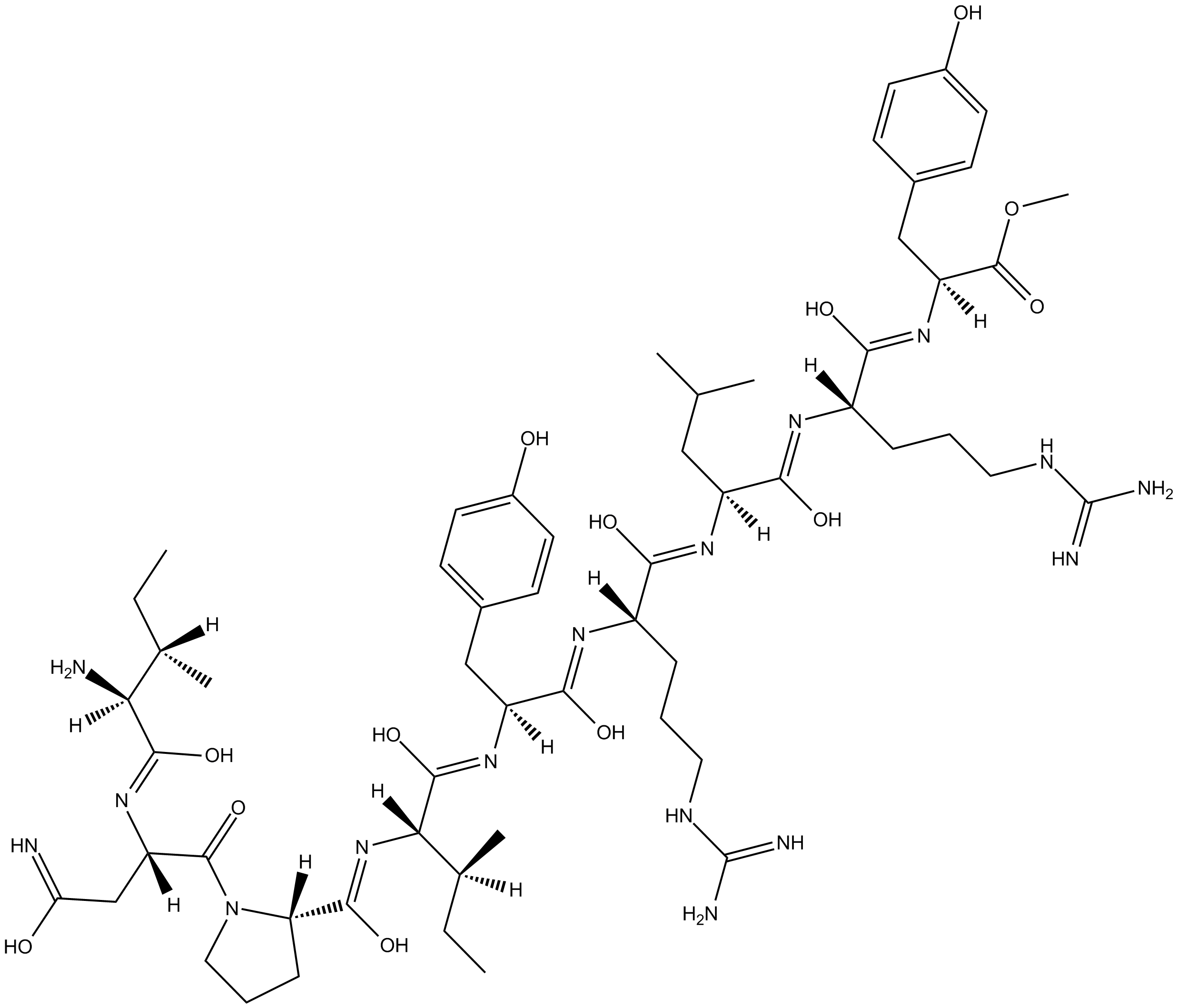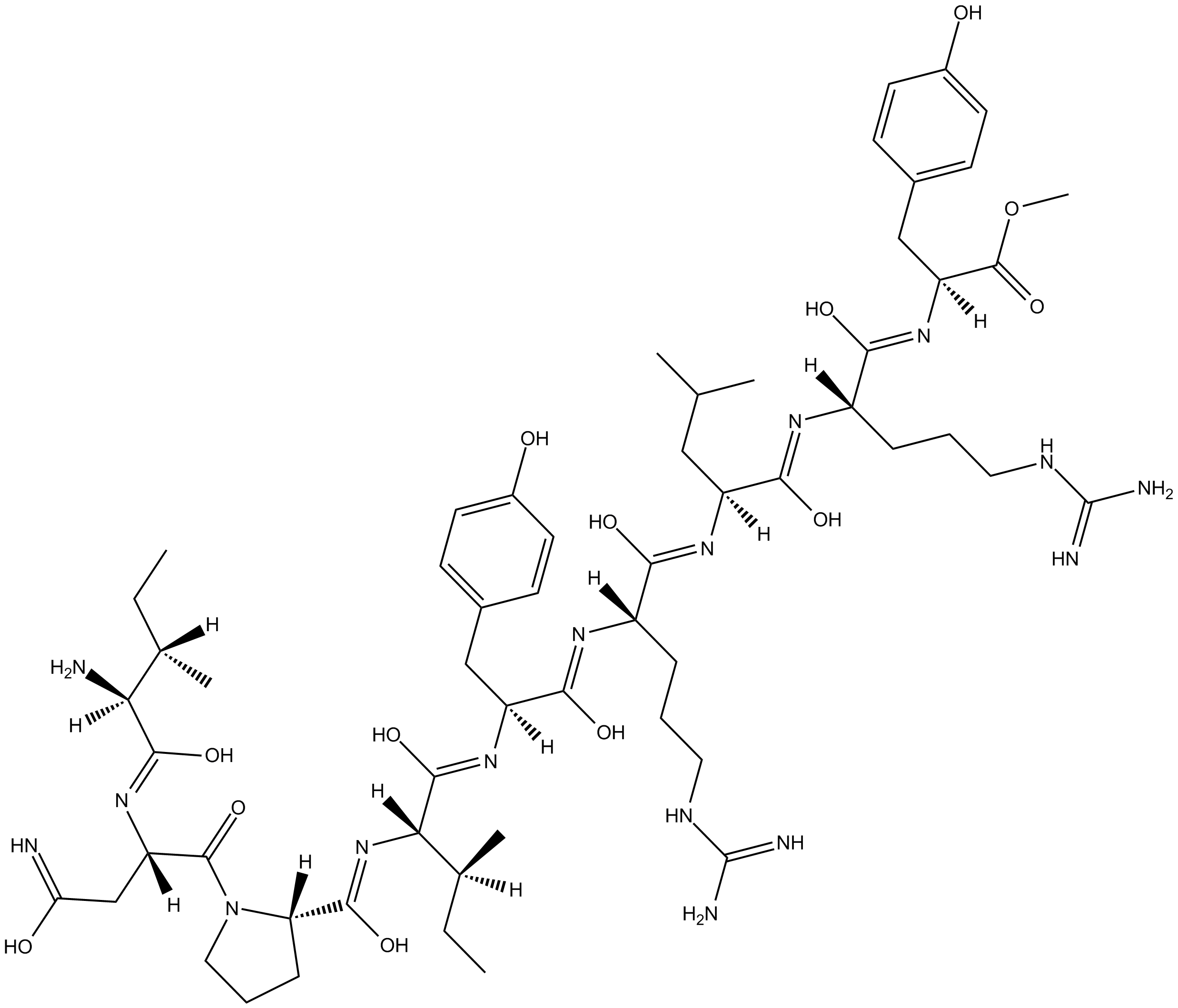BVD 10
Ki: 25.7 nM for Y1
Neuropeptide Y (NPY), a 36-residue peptide amide isolated originally from porcine brain, is a member of homologous hormone family including peptide YY (PYY) and pancreatic polypeptide (PP). It is the most abundant peptide in the mammalian brain and has been shown to exhibit a wide spectrum of central and peripheral activities. These actions are mediated by at least six G-protein coupled receptor subtypes denoted as Y1, Y2, Y3, Y4, Y5, and y6. BVD 10 is a highly selective and potent neuropeptide Y (NPY) Y1 receptor antagonists.
In vitro: The inability to form such hydrogen bonding in BVD 10 may prevent or perturb the C-terminus reverse turn, which may contribute, at least in part, to the increased Y1 selectivity [1]. Moreover, BVD 10 and its NPY analogue peptide BVD15 were characterized conformationally. The two peptides exhibit different secondary structure characteristics in trifluoroethanol. Molecular modeling studies suggested that the C-terminus Tyr9 is oriented in different directions in the two peptides. The difference in the structures observed may contribute to the Y1 selectivity of BVD 10 relative to BVD 15 [2].
In vivo: No animal in vivo data have been reported so far.
Clinical trial: Up to now, BVD 10 is still in the preclinical development stage.
References:
[1] Balasubramaniam A, Dhawan VC, Mullins DE, Chance WT, Sheriff S, Guzzi M, Prabhakaran M, Parker EM. Highly selective and potent neuropeptide Y (NPY) Y1 receptor antagonists based on [Pro(30), Tyr(32), Leu(34)]NPY(28-36)-NH2 (BW1911U90). J Med Chem. 2001 May 10;44(10):1479-82.
[2] Jois SD, Balasubramaniam A. Conformation of neuropeptide Y receptor antagonists: structural implications in receptor selectivity. Peptides. 2003 Jul;24(7):1035-43.
| Physical Appearance | White lyophilised solid |
| Storage | Desiccate at -20°C |
| M.Wt | 1221.46 |
| Cas No. | 262418-00-8 |
| Formula | C58H92N16O13 |
| Solubility | Soluble to 1 mg/ml in H2O |
| Chemical Name | (S,Z)-1-((S)-2-((Z)-((2S,3S)-2-amino-1-hydroxy-3-methylpentylidene)amino)-4-hydroxy-4-iminobutanoyl)-N-((4S,5Z,7S,8Z,10S,11Z,13S,14Z,16S,17Z,19S,20S)-7,13-bis(3-guanidinopropyl)-6,9,12,15,18-pentahydroxy-4,16-bis(4-hydroxybenzyl)-10-isobutyl-20-methyl-3-o |
| SDF | Download SDF |
| Canonical SMILES | CC[C@]([C@@](N)([H])/C(O)=N/[C@@](C(N1CCC[C@@]1([H])/C(O)=N/[C@@](/C(O)=N/[C@@](/C(O)=N/[C@@](/C(O)=N/[C@@](/C(O)=N/[C@@](/C(O)=N/[C@@](C(OC)=O)([H])CC2=CC=C(O)C=C2)([H])CCCNC(N)=N)([H])CC(C)C)([H])CCCNC(N)=N)([H])CC3=CC=C(O)C=C3)([H])[C@@](CC)([H])C)=O)( |
| Shipping Condition | Small Molecules with Blue Ice, Modified Nucleotides with Dry Ice. |
| General tips | We do not recommend long-term storage for the solution, please use it up soon. |
Quality Control & MSDS
- View current batch:
-
Purity = 98.00%
- COA (Certificate Of Analysis)
- MSDS (Material Safety Data Sheet)
- Datasheet
Chemical structure









